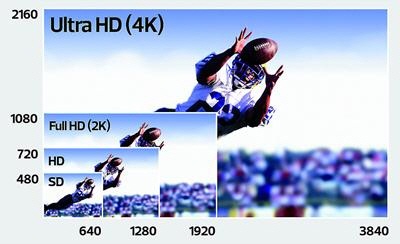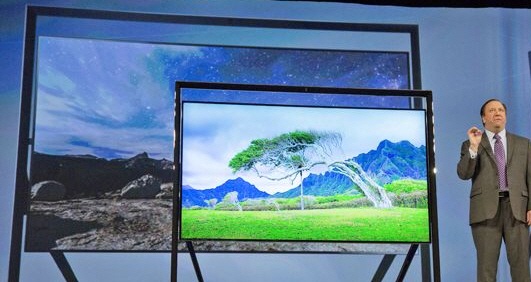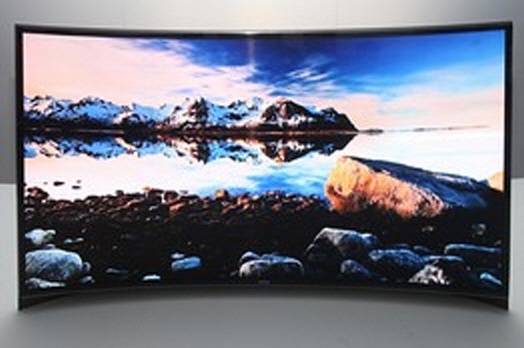A number of folks who recently read through our collection of 2013 mobile resolutions/predictions commented to us on our goal of achieving a 90 percent success rate - but the interesting thing commented on wasn't about the 90 percent we expected to get right, but about the 10 percent that we specifically noted we had a very low confidence level in achieving. Given our total number of predictions, that means we are anticipating missing out on one and a half predictions.
The half prediction is about the mobile patents wars, and we confess it is kind of boring. The other of those predictions - and we admit it is our absolute favorite - is anything but dull, and it was that we would acquire an 85 inch Samsung Ultra High Definition 3D TV in the second half of the year, along with an advanced Samsung Galaxy smartphone to control it. The comments for the most part ran along the lines of hoping this prediction would come true and damn the rest of them (though we ourselves can't damn the rest of our predictions)!
What's the big deal with Ultra High Definition (UHD) TV anyway? Well, take a look at the following image:

Doubling both the horizontal and vertical HD resolution delivers almost 4000 pixels across the TV (hence the original "4K" moniker for them). UHD resolution hits 2160x3840 (exactly double HD's 1080x1920). Aside from the total amount of picture information that can be provided, the resolution is absolutely stunning. No image of the display can do it justice - it is something that needs to be seen.
Here is another very interesting fact. Did you know that when you watch 3D on an HD TV you really end up with half the HD resolution? That's because the content is split in half - one set for the right eye and one set for the left eye. That's right, 3D degrades the resolution substantially, though we're usually too busy enjoying the overall 3D effect to really notice it. UHD resolution essentially means that you will be able to get 3D in full HD quality. Once you see 3D in full HD resolution, well…
We really don't need to wait for a Samsung 85 inch UHD TV - LG happens to already have an 84 incher complete with motion sensing remote control and passive 3D (the LG 84LM9600) already on the market - and it may be had for possibly as low as $17,000. But part of our prediction involves Samsung also delivering an advanced Galaxy smartphone that would also control the TV. There are all sorts of Smart TV possibilities here that we won't go into, but use your imagination.
Samsung did in fact debut (as we anticipated in our predictions) its S9 85 inch UHD TV at the 2013 Consumer Electronics Show (CES) several days ago. And on the show floor they also have astounding 95 and 110 inch versions of it. Samsung tells us that these bigger TVs are concepts that demonstrate technology - we won't see them any time soon (and leaving aside that they would probably cost more than our dream Porsche 911 if they were real products today). But hell, 85 inches will do just fine. The image below provides a clue to what these huge sizes actually amount to.

Equipped with voice and touch activation features, in addition to what Samsung refers to as its S-Recommendation system that suggests programs to watch, lead's to Samsung's CES claim that "The TV is almost human." Though we doubt the recommendation system will prove to be anything more than a gimmick (at least for us), the rest of the package inspires lust. Availability and price were not provided, but we suspect it will fall in the $25,000 range and will become available late fall this year.
That said, there will be no mention from Samsung of a next generation Galaxy phone to control the S9 at CES. We'll have to wait for the upcoming Mobile World Congress to hear anything more on the Samsung smartphone front - and its potential ties to the TV.
Here's another "did you know" for you: At 85 inches we are starting to push the boundaries of being able to actually move and maneuver these TVs - making angled turns with them could prove impossible even in large homes. Regarding the 110 inch version of the S9, it wasn't available at the Samsung S9 event, which was held in one of the Mandalay Bay's ballrooms. Samsung noted that "At nine-feet across, we were afraid we couldn't get the S9 through the doors!"
UHD Means More Affordable High Function HD
While we would actually be able to slip Samsung's S9 into our media room, it isn't going to happen any time soon with those starry-eyed price tags. But their availability on the ultra-high end spells out great news on the formerly high end - which is now rapidly evolving into the low end. We certainly could make do with the near-affordable 80 inch Sharp HD TV we saw at last year's CES.
The valuable thing for the consumer marketplace is that all the cool peripheral technology (the stuff that "makes TVs almost human") that surrounds the high end UHD toys will also be available at the new low end of the spectrum - which we can happily note also represents a huge number of "to lust after" TVs. HD still looks fabulous. Samsung, Sony, LG, Pioneer, Panasonic, Vizio - all of them already deliver HD toys that fit into anyone's budget. But to remain competitive at any price point they all need to deliver on the smart TV, voice and motion control, and so on.
The quality and capabilities of the more common 30 to 55 inch HD TVs that are now available is extraordinary relative to their affordable prices. We strongly anticipate that the 40 to 42 inch screen size will eventually become the first really affordable UHD TV model that will go main stream. By then there may also actually be true UHD content available. At this point, all a UHD TV can do is up-convert existing HD content to UHD.
Meanwhile, toys like Microsoft's Kinect will soon be able to actually recognize individuals in a room. That sort of capability will also make TVs smart by setting user preferences, predetermined stations or programs, and so on. Interfaces become fluid and dynamic and the table full of remote controls disappears.
None of this requires a $25,000 85 inch UHD TV to make happen. But UHD availability drives down the HD prices, and this is the true immediate benefit to all of us.
Meaning What Exactly for Apple's TV?
Unlike the mobile phone market, and to a great degree the old-school (Microsoft-enabled) tablet market that predated the iPhone and iPad, today's TV market is most emphatically not stuck in the 20th century. The TV market - and all of the related mobile components now associated with it - is rapidly moving forward. It is a thrilling market that is teaming with hot tech.
That leaves us scratching our heads as to what exactly Apple can bring to the TV table either very late this year or, as currently appears more likely, in the first half of 2014. Apple is most assuredly not going to suddenly be able to take a leadership position in the TV market, as it did with the iPhone and iPad (and to be honest, as it did with the iPod). iTV is going to be a different beast and Apple runs the very real danger - we are anticipating this in fact - of operating exactly as Microsoft has in the mobile space for the last eight years - by which we mean well behind the technology curve and merely and unconvincingly posturing as being at the forefront.
Nothing would kill off iTV faster than Apple delivering TV products that do not significantly raise the bar in the same way that the iPhone and iPad did. The TV market, by virtue of Samsung and LG in particular, and the others we noted above following in step, is a vibrant and forward-thinking technology market from both the hardware and software end of things. And we believe that Samsung and LG have display capabilities in hand Apple won't ever be able to catch up on and take a lead over.
We are very hard pressed to see a "hardware" TV product that Apple can deliver that will capture anyone's imagination. Samsung owns this we believe, and it gives Samsung a strategic edge over Apple - and one that Samsung need not worry about on the patent front. Though we anticipate the next generation iOS 7 capabilities and UI/UX to take a major leap forward when it is introduced early in the second half of 2013, anything Apple can derive from this and apply to a TV will not be nearly enough to drive meaningful levels of demand. Or at least not the kind of demand necessary to drive non-trivial Apple revenue.
Here are the minimum requirements for us:
- 42 inch bendable screen (good luck with that!)
- UHD
- Active or passive 3D
- Mobile/Wireless Motion Control
- Seamless integration with iOS 7.x (of course)
- Bi-direction built in camera for Facetime and for facial recognition
We'll leave it at this head-scratching point for now, but we invite our readers to send us thoughts on what Apple needs to deliver on the TV front in order to really convince you to buy one. We'd love to assemble such a compilation - and we'll then forward it to Apple.
BTW, just a bit more on that issue of not being able to maneuver those ultra large UHD TVs. We'll just have to wait for the bendable screen versions of them. And if CES 2013 and Samsung have anything to suggest, well, it's more real than you might think, as the Samsung curved TV shown below points out!

A large bendable screen delivers far more depth to the user's overall visual experience - not unlike an IMAX theater screen. But we'll settle for being able to bend it around the corners.
Edited by
Brooke Neuman